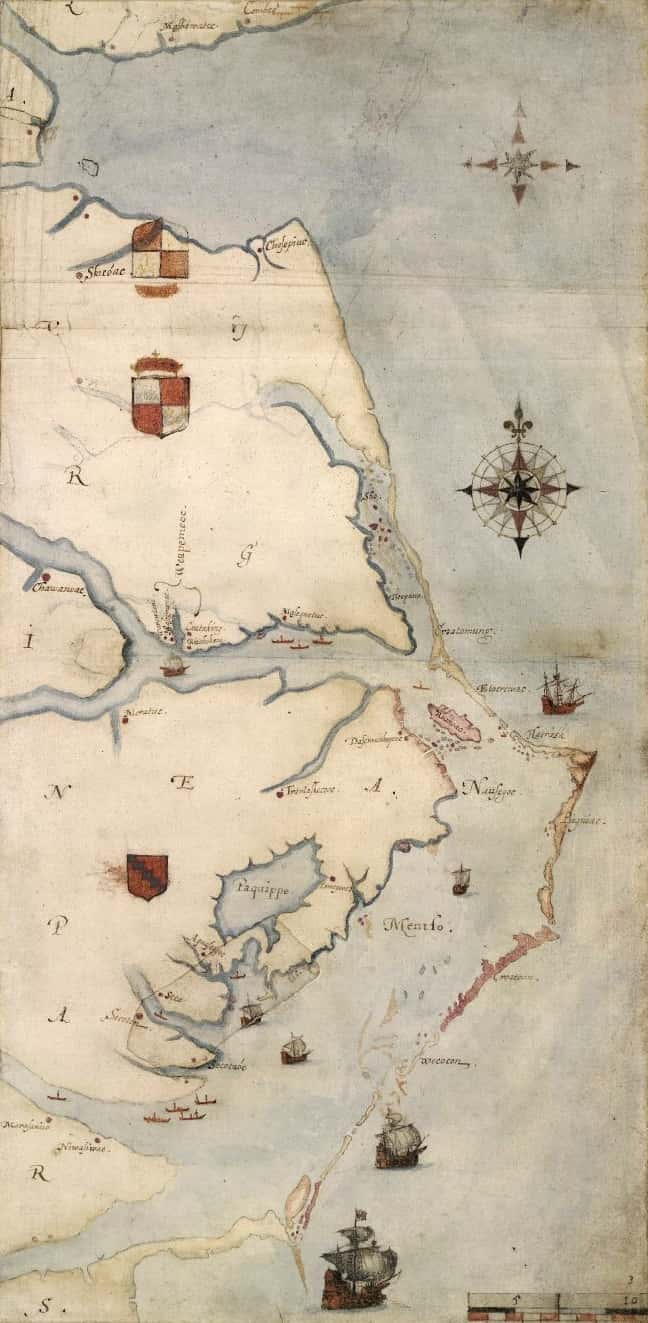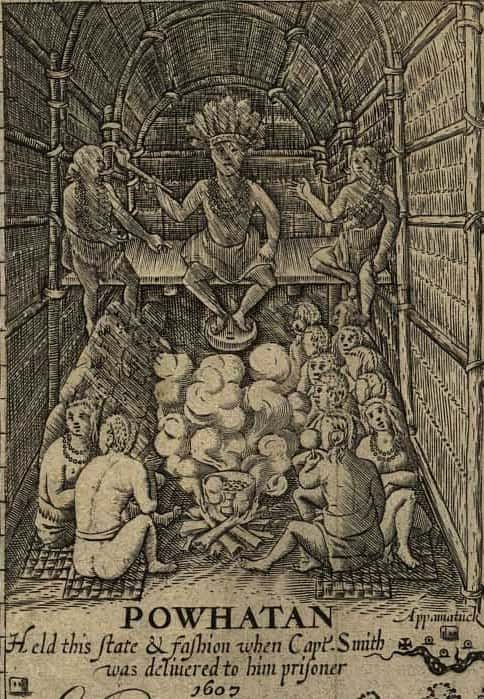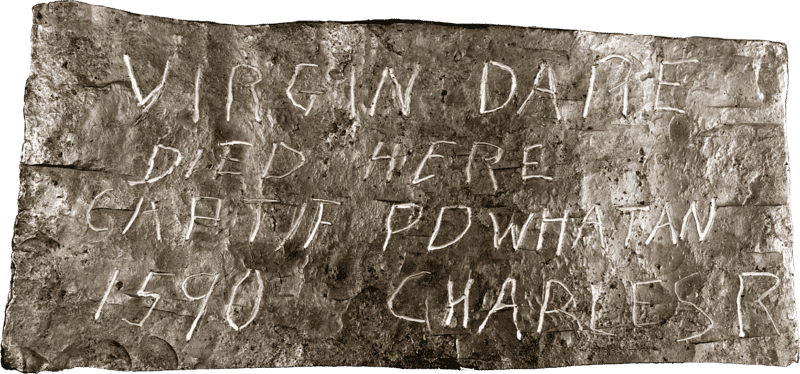Roanoke Editorial
On a misty August day in 1590, the British colonist and watercolor painter John White finally disembarked from one of his ships, the Hopewell and the Moonlight. It had been a hard journey—full of threats from the Spanish, stormy weather, and battles at sea—but finally, he returned to the colony he settled three long years before: Roanoke.
As White stepped onto what is now known as American soil, he hoped to find the settlement thriving. Along the way, he and his crew witnessed smoke rising from the area and found tracks in the soil once they landed.
All signs were positive, with White probably noticing the happy timing of his arrival. He reached Roanoke Island on the exact day of his little granddaughter’s third birthday. He likely expected to find little Virginia Dare, the first English child born on American soil, happy and plump with her doting parents.
But John White wouldn’t be able to wish his granddaughter a happy birthday. He wouldn’t even be able to say hello. As the explorer and his crew walked towards the colony, they realized that something was very wrong.
Roanoke: An Eerie Discovery
The colony had been built and even fortified, but there was no bustle, no sign of industry, no sense of community. Indeed, someone had carefully dismantled the settlement. It was as though the town had decided to tear down the village and travel elsewhere. But why would they abandon their post?
As White and his sailors searched for clues about what happened, they feared the worst. There may have been a terrible battle. Perhaps a mysterious illness had ravaged the community. But there were no signs of either a conflict or a graveyard. Evidently, no one had attacked the town. There was no mass epidemic. Whatever happened was far, far stranger. Somehow, all the settlers of Roanoke had vanished into thin air.
What Happened To The Roanoke Colony?
After hunting for clues about the fate of the Roanoke colony, the sailors only found two eerie traces. Someone had carved three mysterious letters into a nearby tree: “CRO.” The fort’s post revealed the full meaning of the incomplete message. It bore a complete word, “CROATOAN.” These messages were the only clues to the Roanoke settlers' fate.
How does a settlement of over 100 people disappear? Who holds the key to what happened at Roanoke? What does “Croatoan” mean? For centuries, the enigma of the “Lost Colony” has haunted mystery hunters. Archaeologists still don’t conclusively know what happened at Roanoke. Still, there are plenty of strange theories about the eeriest vanishing act in American history.
Theory One: Massacre, with a Twist
In the early 1600s, priests warned the Powhatan chief Wahunsenacawh about a dire prophecy. A group from Chesapeake Bay would rise up and conquer his territory. Intent on retaining his power, Wahunsenacawh decided to take matters into his own hands. He didn't wait for this new power to provoke a battle. Instead, the Powhatan leader went to the Chesepian Tribe in Chesapeake (where the Roanoke settlers had moved) and slaughtered the English residents there. With their deaths, Wahunsenacawh believed he had averted prophecy...
Or so William Strachey said.
The settler’s sensational version of events spread far and wide after he first proclaimed his tale in 1612. However, modern historians now doubt Strachey’s chilling explanation. After all, Strachey believed that the Powhatan religion was Satanic. This had led many scholars to think twice about his blood-soaked tale. Instead of revealing Roanoke’s fate, Strachey may have used the village’s vanishing act to spread his racist ideas about Indigenous peoples.
Theory Two: A Perilous Voyage
Life in the American wilderness was hard. For some historians, the grueling weather, tense relationships with nearby Indigenous tribes, and lack of infrastructure may have been too much for the Roanoke settlers. They could have decided to throw in the towel and sail back to England.
After all, they had a ship (Sir Walter Raleigh’s earlier trip to Roanoke left behind a small boat called a pinnace) and some of the settlers may well have been sailors who felt confident with their ability to man a ship. If they did decide to try to sail all the way back home, they would have been taking quite the risk. Pinnaces could technically complete the journey, but it was rare to do so without tagging along with a larger ship.
If the Roanoke settlers were so desperate that they decided to risk death to get home, it looks like their plan didn’t work out. There is no record of any of the settlers ever arriving in England. Even stranger, there is no way that the entire colony could have fit on one small boat. This theory may explain how some of the settlers perished, but it doesn’t answer what happened to the people who stayed at Roanoke.
Theory Three: Integration and Assimilation
Most historians believe in another turn of events: the Roanoke settlers gave up their European roots and joined local Indigenous tribes. This would explain the lack of graves and battle sites, and clarify the meaning of the mysterious word “Croatoan.”
After all, the Croatan people were an Indigenous group who lived on Croatoan Island (now called Hatteras Island), just south of the Roanoke colony. When John White left the Roanoke settlement, he told the colonizers that, if they ever had to leave, they should write their next destination down. With that information, White would be able to rejoin the Roanoke settlers.
Perhaps writing “CRO” and “Croatoan” on the tree and post was the town’s way of telling White exactly where they were. They may have even been inviting him to come find them.
The Mysterious Dare Stones
There are many other theories about what happened to the Roanoke settlers, from a Spanish raid to falling victim to a conspiracy to ruin Roanoke’s original settler, Sir Walter Raleigh. However, the most bone-chilling theory is also the one with something rare in the Roanoke mystery: physical evidence.
A man named Louis Hammond was walking around the Chowan River in North Carolina when he stumbled upon a large stone. On one side it read, lightly translated into modern English, “Ananias Dare & Virginia went hence unto Heaven 1591. Any Englishman show [this rock to] John White, Governor of Virginia.”
On the other side, the stone revealed another dark reason for the colony’s disappearance. In Renaissance-style English, it claimed that after White left for England, the Roanoke colony moved to the Chowan River. The settlers experienced nothing but “misarie & warre” for two long years, with over half of the group dying and 24 more perishing from an illness.
Misarie & Warre
Weakened and outnumbered, the Roanoke settlers encountered an Indigenous person who said that there was a ship coming. The tribe became nervous, saying the spirits were angry. The tribe attacked the Roanoke settlers, murdering everyone but seven of the English colonizers.
The tribesmen killed the writer’s child Ananias along with the others, “wth mvch misarie.” The stone concludes by saying that the dead were buried four miles east of the Chowan River, with their names engraved on a rock. The message concluded with the initials “EWD.” Scholars have interpreted the initials as belonging to Eleanor White Dare. Eleanor was the daughter of John White and the mother of little Virginia Dare.
As the years passed, more “Dare Stones” appeared—though archaeologists have revealed all but the very first to be hoaxes. The original “Dare Stone” (also called the Hammond Stone), is still controversial among historians and archaeologists. As of yet, however, there is no conclusive proof that it is a forgery.
The Roanoke Mystery
For John White, no one ever solved the mystery of the vanishing colony. After discovering the silent site that was once Roanoke, White sailed back to England, never to recover from his disturbing loss. He never went back to America and, of course, he never saw his grandchild, little Virginia Dare, ever again. In a letter, White numbly wrote that all he could do was beg God to “helpe and comfort” the vanished Roanoke settlers. Without any clear archaeological evidence, for the time being, we may be in the same boat.


















